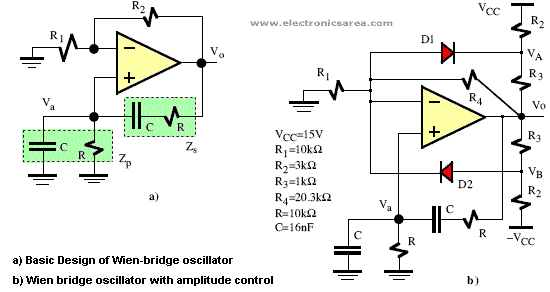Sep 182014
Wien-bridge Oscillator using Op-Amp
The Wien-bridge oscillator, as shown on the basic outline of the diagram below, consists of an Operational Amplifier (OA) in a non-inverting configuration with gain 1+R2/R1 and a RC feedback network with the following transfer function:
Where:
Combining the first and the second equation, we get:
The loop gain (BA) is:
The Barkhausen criterion defines the conditions for oscillation at frequency ƒo:
To ensure the conditions of oscillation, R2/R1 must be chosen slightly higher than 2 to correct small variations in the circuit.
Furthermore, the amplitude of oscillation can be determined and stabilized using a nonlinear circuit as shown in picture above. The diodes D1 and D2 and resistors R2 and R3 act as limiting the output amplitude.
You may be interested in:
- Sinusoidal oscillator (basic structure)
- Sinusoidal oscillators – Basic principles
- UJT Relaxation oscillator circuit
- Crystal Oscillators – Piezoelectric Oscillator. Equivalent circuit
- LC Oscillator – Inductance – Capacitance Oscillator
- Phase Shift Oscillator
- Wien-bridge Oscillator with Op Amp
- Nonlinear Amplitude Control of a Sinusoidal Oscillator










